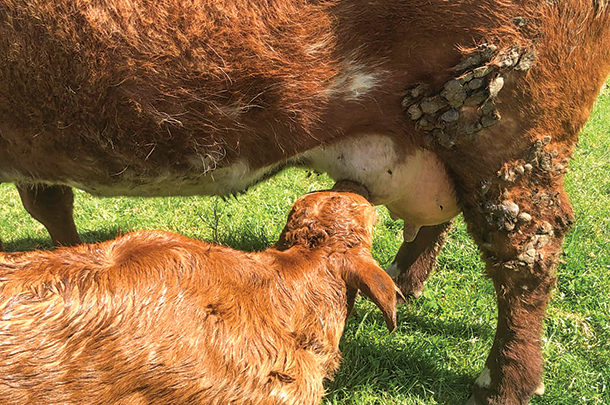As more beef producers adopt this technology, a central goal remains: to get as many healthy offspring from the donor cow as possible while maintaining her health and production.
While harvesting the oocytes and creating and implanting the embryos is critically important, it’s also important to make sure the development of the fetus inside the recipient and subsequent calving is as stress-free as possible. Because while the donor plays a critical role, those calves should be genetically superior and represent the future of your or your clients’ herds.
As we plan for gestation and subsequent calving, management should focus on the genetics of the embryo, recipient cow condition, gestation length and projected calving date.
Match embryo to recipient
Matching embryo genetics with appropriate recipients is the first step to a successful calving season. Expected progeny differences (EPDs) are a great tool to predict offspring traits from specific matings. Use calving ease direct (CED) and birthweight EPDs to select recipient females that will match up with potential calf size. This is especially important if first-calf heifers are used as recipients. Place calving ease embryos in younger females and use cows to carry larger or less- proven genetics. However, the ideal recipients to utilize in an embryo transfer (ET) program would be 3 to 5 years of age with calving experience and higher-quality colostrum than younger females. Recipient cows are carrying high-quality genetics, so selecting the best will help raise the quality of embryo calves you hope to see in nine months.
After embryos are placed in recipients, start pregnancy detection at 45 days post-implantation. At this time, the embryo is fully attached to the placenta, and the chance of fetal abortion is low. Schedule a time with a veterinarian to pregnancy check recipients sometime between 45 and 90 days post-implantation for best calving season planning. After 100 days of gestation, it becomes difficult for the veterinarian to accurately predict fetal age due to size and safe access to the fetus. Once pregnancy is confirmed, pre-calving vaccinations can be scheduled to ensure the most effective response based on calving date.
Manage recipients like donors
Recipient nutrition and health management should be managed the same as one would care for the pregnant donor. Measure body condition score (BCS) of pregnant recipients at key times in gestation to gauge energy reserves leading up to calving. Cows should calve with a BCS of 5.5, using a scale from 1 to 9. Each point in the BCS scale is about 100 pounds, so recipients at a 5 BCS at the beginning of the third trimester need to gain 50 pounds to reach a 5.5 BCS by calving. Use this guide to develop appropriate rations for recipients going into calving season and postpartum.
Work with a trained nutritionist to develop mid-gestation, third-trimester and postpartum rations based on accurate feedstuff analysis. Creating rations for these three critical time periods will help meet cow nutrient requirements to support the growing fetus (Figure 1) while maintaining cow condition.

Sufficient nutrients delivered pre- and postpartum will improve resumption of future estrus cycles and subsequent conception and pregnancy rates.
Keep accurate records
Compile a list of embryo transfer dates and projected calving dates for all recipient cows, and reference these often as calving season nears. Certainly not all cows will follow a normal calving schedule, so pay attention to lactation development, behavior and other calving signs. Paying close attention will identify cows that are near calving or signal cows that might be overdue.
Include your veterinarian
Because recipients can be carrying very valuable calves, it’s a good idea to have a plan in place with your veterinarian to ensure the recipients carrying the calves avoid dystocia, the calves are thrifty and postnatal calf care is solid.
Dr. Patricia Parrish, a veterinarian in Ohio, works with clients that utilize IVF technology. She suggests producers check cows for visual signs of calving every 12 hours, at a minimum. Even if the cow is calving outside, Parrish recommends a dry, low-pressure calving environment. Intervene early at any sign of a difficult calving, and make sure the calf gets adequate colostrum within four hours of birth.
Once the calf is on the ground, data should be collected on the calf and cow. Measure and record birthweight, calving ease score, milk production and calf vigor, and use that data when making future IVF mating decisions. While gender differences may play a role in birthweight, this data can be useful in the future if embryos are sold or if questions come up on calf size. Post-calving care can also include navel dips, tagging, tattoo and DNA collection to aid in genetic testing and registration down the road.
Parrish has these general requirements for calving IVF calves:
1. Create a controlled calving environment where interventions for dystocia can be made.
2. Give each calf the best chance for an easy start with adequate colostrum.
3. Be prepared with calf care products and colostrum replacer.
4. Create a post-calving care plan unique to your operation.
IVF is a way to quickly fast- forward genetics. The ability to produce genetics from young females who have yet to birth their first calf speeds up the generation interval that would take decades with natural breeding. With the right recipient and calving management, IVF can become a valuable tool for your herd. ![]()
PHOTO: A Red Angus heifer made via Vytelle IVF, owned by David Morgan of Oregon. Photo provided by Vytelle.
References omitted but are available upon request. Click here to email an editor.

-
Taylor Grussing
- Special Projects Manager
- Vytelle
- Email Taylor Grussing










